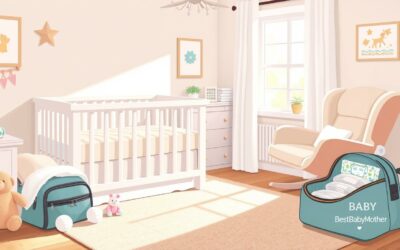Are you ready to learn the secrets of caring for your newborn? Starting your parenting journey can be exciting and a bit scary. You might wonder how to keep your baby healthy and build a strong bond with them. By learning, asking for help, and gaining confidence, you’ll become great at caring for your baby.
Good parenting starts with knowing the basics of newborn care. This includes feeding, sleep, emotional connection, and safety. Our guide has all the info you need for these early days. Let’s explore tips that will make caring for your baby a joy.
Key Takeaways:
- Newborns sleep 2 to 3 hours at a time, both day and night, for about 16 hours a day.
- Changing your baby’s nappy often helps prevent nappy rash.
- Getting support from friends, neighbors, and family is great for new parents.
- Skin-to-skin contact with caregivers, like dads, can calm your baby.
- Parents who ask for help tend to do better with breastfeeding and may nurse longer.
- Techniques like swaddling and shushing can really soothe your baby.
Getting Help After Bringing Your Baby Home
Welcoming a new baby home is joyful but also brings big changes. Getting help is key to keep you and your baby happy and healthy.
Accepting Support from Friends and Family
Getting help from family and friends is very helpful. They can share their own experiences and help out, like cleaning or watching the baby. This support lets you focus more on your baby.
Taking Care of Yourself as a New Parent
It’s important to take care of yourself too, just like your baby. Even a short nap or a warm shower can help a lot. Newborns sleep a lot, giving you chances to rest. Taking care of yourself helps you care for your baby better.
Establishing Boundaries with Visitors
It’s normal for people to want to visit your new baby. But, it’s important to manage these visits. In the first weeks, it’s good to limit visitors. This helps you focus on your baby and rest.
Handling Your Baby Safely
Keeping your newborn safe is very important. They are very delicate. Safe baby handling helps protect them and keeps infections away. Here are the key steps to keep your baby safe.
Importance of Hand Hygiene
Keeping your hands clean is key to stopping infections. This is especially true in the first two months. Always wash your hands before touching your baby. This simple step keeps your baby safe from germs.
Supporting the Head and Neck
Newborns have soft spots on their heads. Always support their head and neck when picking them up. This is for infant protection. To do this right, place one hand under their head and neck and the other under their bottom. This gentle care is very important for safe baby handling.
Avoiding Rough Play
Don’t shake or bounce your baby hard. This can hurt them badly, like brain injuries. Always hold them securely, especially on stairs. This keeps them safe and happy.
By following these tips, you not only protect your baby but also help prevent infections. This keeps their baby immune system strong. It ensures they stay healthy and safe.
Bonding with Your Baby
Bonding with your baby is a joyous part of being a new parent. It’s more than fun; it’s vital for your baby’s growth. It helps them develop well and feel safe.
Showing love and care when your baby needs it builds a strong bond. This bond is based on trust and love.
Skin-to-Skin Contact
Skin-to-skin contact, or kangaroo care, is great for bonding. It makes your baby feel safe and secure. It also helps them sleep better and feel less stressed.
This special touch boosts brain growth and bonding. It’s a powerful way to connect with your baby.
Techniques for Building Emotional Connection
Building a strong emotional bond with your baby takes effort. It’s about showing love and understanding their needs. Here are some ways to do it:
- Engage in plenty of cuddle time and gentle stroking.
- Talk, sing, or make facial expressions while maintaining eye contact.
- Understand and be responsive to your baby’s preferences and moods.
- Introduce touch-based activities like infant massage.
These moments are key to a strong bond. They help your baby learn about emotions and words. Building this bond takes time, but it’s worth it for both of you.
Soothing Techniques for Your Baby
As a new parent, it’s key to know how to calm your baby. Using the right techniques can greatly improve your baby’s comfort. This section will cover methods like baby massage, vocal sounds, music, and the swaddle technique.
Gentle Infant Massage
One top way to soothe a newborn is through gentle infant massage. Studies show it can cut down crying and boost sleep. Soft strokes on your baby’s back, arms, and legs can make them feel safe and relaxed.
This touch therapy not only relaxes your baby but also strengthens your bond.
Using Vocal Sounds and Music
Your voice is a powerful tool for calming your baby. Soft talking, babbling, or cooing can really comfort them. Many parents find singing lullabies or playing soothing music helps a lot.
Using white noise machines at bedtime can also soothe a newborn. It creates a womb-like sound environment.

Effective Swaddling Methods
Swaddling is a reliable way to soothe a newborn. It wraps your baby snugly in a blanket for security and to reduce the startle reflex. The swaddle should be snug but not too tight, allowing for hip movement.
Swaddling is best for young babies, especially newborns, due to its movement-limiting nature.
| Technique | Recommendation |
|---|---|
| Baby Massage | Gently stroke back, arms, and legs to promote relaxation |
| Vocal Sounds and Music | Use soft talking, singing lullabies, or playing soothing music |
| Swaddle Technique | Wrap newborns snugly in a blanket to reduce startle reflex |
Try each soothing technique before moving on to another. Be patient, as newborns don’t self-soothe until 3 to 6 months. If calming your baby is still hard, talk to a pediatric professional.
Diapering Your Baby
Diapering is a big part of being a new parent. Knowing how to use cloth or disposable diapers helps keep your baby clean and comfy.
Choosing Between Cloth and Disposable Diapers
Choosing between cloth and disposable diapers is a big decision. It affects your daily life and your baby’s comfort. Think about cost, ease, and how it’s good for the planet.
Cloth diapers come in many styles, like old-fashioned ones with pins and newer ones with Velcro. Use big pins with plastic heads to avoid pricking. Disposable diapers are easy to use and throw away when dirty.
Think about what diapers are made of too. Cloth diapers need special washing to avoid skin problems. Disposable diapers need to be changed often to keep them from smelling bad and causing rash.
Proper Diaper Changing Procedures
Learning to change diapers well makes it easier for you and your baby. Keep all diapering essentials close by. You’ll need a changing pad, clean diapers, ointment, wipes, and extra clothes.
- Always wash your hands first.
- Put your baby on a clean changing pad. Never leave them alone, as babies can roll.
- Take off the dirty diaper and clean the area gently with warm water. Wipe from front to back to avoid infections.
- Make sure the area is dry before putting on a new diaper. Use ointment with zinc oxide to protect.
- Make sure the diaper fits well but not too tight. Check for marks on legs and waist.
Changing diapers often keeps your baby comfy and prevents rash. You might change diapers up to 3,000 times in the first year. So, having a routine is key.
For boys, make sure the penis is down before you fasten the diaper. For uncircumcised boys, just clean the outside parts without touching the foreskin.
| Aspect | Cloth Diapers | Disposable Diapers |
|---|---|---|
| Cost | Higher upfront cost | Costs more over time |
| Convenience | Needs washing and care | Easy to use once |
| Environmental Impact | Good for the planet, reusable | Creates landfill waste |
| Health Impact | Less chemicals | Has chemicals |
Choosing cloth or disposable diapers is up to you. But, changing diapers often and keeping them clean is crucial. Letting your baby go without a diaper for a bit can help prevent rash. If a rash doesn’t get better or gets worse, see a doctor right away.
Bathing Your Newborn
Bathing your newborn can be both exciting and a bit scary. The American Academy of Pediatrics suggests starting with sponge baths until the umbilical cord stump falls off. This usually takes one to two weeks. It’s important to keep your baby clean without getting them wet too soon.

Experts say wait at least 24 hours for your baby’s first bath. This can help with breastfeeding in the hospital. Instead of daily baths, clean your baby’s face, neck, hands, and bottom. This helps keep their sensitive skin moist.
When you start using a tub, make sure the water is not too hot. It should be around 100°F (38°C). The room should be warm enough to keep your baby cozy. Fill the baby tub with about 2 inches (5 centimeters) of water. Newborns need to be bathed only three times a week, unless they get dirty.
Keeping your baby safe during baths is very important. Always watch them and don’t use baby bath seats because they can tip over. Make sure the water is not too hot by checking the faucet temperature. Start by washing your baby’s head and face first. This helps avoid getting cleaned areas dirty again.
When washing your baby’s hair, use mild baby shampoo. Make sure no shampoo gets in their eyes. After their bath, they usually don’t need lotion unless their skin is very dry. In that case, use unscented baby moisturizer. Talking to your baby during baths helps them relax and get used to your voice.
It’s very important not to leave your baby alone in the bath. Most child drownings happen in bathtubs, especially with babies under one year old. Bathing your newborn is about keeping them clean and creating a safe, loving space for them.
Caring for Umbilical Cord and Circumcision Area
It’s important to take good care of your newborn’s umbilical cord and circumcision area. This helps prevent infections and aids in healing. With the right steps, you can keep these areas clean and promote healing.
Umbilical Cord Care
Umbilical cord care is key in the early days. Keep it clean and dry with a damp cloth. Make sure it gets air to dry. The cord stump usually falls off in one to three weeks.
Avoid pulling on it. Use sponge baths instead of full baths to keep the stump dry.
- Wipe the stump with a clean, damp cloth.
- Allow air exposure to promote drying.
- Use sponge baths instead of full baths.
- Avoid covering the stump with the diaper.
Circumcision Care
After circumcision, your baby needs special care. Pain, swelling, and redness are common. Follow these newborn care instructions for a smooth recovery:
- Gently clean the penis with soap and water 2-4 times daily.
- Apply antibiotic ointment or petroleum jelly to prevent sticking to the diaper.
- Use acetaminophen (Tylenol®) for pain relief, as recommended by your doctor.
The plastic ring usually falls off in 5 to 7 days. Swelling can last up to 4 days. Watch for signs of infection like pus or redness spreading.
If your baby has severe pain, bleeding, fever over 101°F, or infection signs, get medical help fast.
| Post-Circumcision Care | Details |
|---|---|
| Duration of Surgery | Approximately 1.5 hours |
| Plastic Ring Falls Off | 5 to 7 days |
| Swelling Duration | Up to 4 days |
| Cleaning Frequency | 2 to 4 times daily |
| Pain Relief | Acetaminophen (Tylenol®) |
Following these post-circumcision care tips helps your baby feel better. Taking care of both the umbilical cord and circumcision area is key. It helps prevent infections and keeps your baby healthy.
Baby Feeding Guidelines for New Parents
Feeding your newborn is very important for their growth. Knowing how to feed them and spotting baby hunger signs is key. Here are some tips for infant nutrition.
Breastfeeding Tips
One natural way to feed is through breastfeeding. Good breastfeeding support helps you and your baby. Newborns need eight to 12 feedings a day, every two to three hours.
Watch for wet diapers and bowel movements to see if they’re getting enough milk:
- At least six wet diapers and three or more bowel movements by the fifth day after birth.
- Consistent weight gain and contentment between feedings are positive indicators.
Formula Feeding Considerations
If you’re formula-feeding, knowing the right amounts and times is crucial. Here are some key points for formula-feeding your newborn:
- In the first week, babies typically consume 1 to 2 ounces of formula per feeding.
- By the end of the first month, this amount usually increases to 3 to 4 ounces per feeding.
- At around 4 months, babies may consume 4 to 6 ounces per feeding every three to four hours.
- Between 6 and 12 months, infants may take in 7 to 8 ounces per feeding about four to six times a day.
Formula-fed newborns have more scheduled feedings than breastfed ones because formula takes longer to digest.
Identifying Hunger Cues
Spotting baby hunger signs helps you feed on demand. This ensures they get enough nutrients. Look for these signs:
- Rooting reflex – turning their head towards a touch on their cheek.
- Opening and closing their mouth or making sucking noises.
- Bringing their hands to their mouth.
- Fussing or crying, which can be a late sign of hunger.
These signs mean your baby is hungry before they get upset. By watching for these early signs, you can keep a flexible feeding schedule. This works for both breastfeeding support and formula feeding.
It’s also important to check in with your doctor regularly. They can help make sure your baby is growing well. If you have any questions about infant nutrition, weight, or feeding, talk to a lactation consultant or your baby’s doctor.
Using the right feeding methods and paying attention to your baby’s cues will help you through the early stages of newborn feeding.
| Baby’s Age | Breast Milk per Feeding | Formula per Feeding |
|---|---|---|
| Newborn | 1-2 oz | 1-2 oz |
| 2 Weeks | 2-3 oz | 2-3 oz |
| 4 Months | 4-6 oz | 4-6 oz |
| 6-12 Months | 6-8 oz | 7-8 oz |
Establishing Healthy Sleep Patterns for Your Baby
Getting your newborn to rest is key for their growth and your peace. Newborns don’t sleep in a regular pattern at first. They wake and sleep in short, random times. On average, newborn resting is about 15 to 18 hours a day, in short periods.
As they grow, you can start setting a regular sleep schedule. This helps create healthy baby sleep habits.
Creating a good sleep space is important for sleep training. Here are some tips:
- 1-4 weeks old: Babies sleep about 15-18 hours a day, in short 2-4 hour periods.
- 1-4 months old: They need about 14-15 hours of sleep daily, with longer stretches at night.
- 4-12 months old: Most babies sleep 14-15 hours a day, sleeping through the night by 6 months.
In the early months, avoid overfeeding to help with sleep. Also, don’t use bottles to prop up your baby’s sleep to avoid health risks. A calming bedtime routine can help prevent sleep deprivation for both you and your baby.
Three naps a day are good, with different lengths for each. By 6 months, they might switch to two naps. If your baby fusses at night, talk to a doctor.
Here’s a guide for your newborn’s sleep patterns and tips:
| Age Range | Sleep Duration | Key Points |
|---|---|---|
| 1-4 weeks old | 15-18 hours/day | Short 2-4 hour bursts |
| 1-4 months old | 14-15 hours/day | Longer 4-6 hour stretches |
| 4-12 months old | 14-15 hours/day | Start to sleep through the night |
Using a pacifier can lower SUIDS risk, but wait until breastfeeding is established. Make sure the crib is safe, with no loose items. Place your baby on their back for sleep to lower SIDS risk.
Good baby sleep habits help your newborn rest better and support your family’s well-being. A consistent bedtime routine helps with sleep training. It sets a good sleep pattern for your baby’s whole childhood.
Protecting Your Baby from SIDS
Sudden Infant Death Syndrome (SIDS) is a big worry for new parents. But, using safe sleep practices can help a lot. One key thing is to put your baby on their back to sleep.
Studies show that back sleeping lowers SIDS risk. If your baby rolls onto their stomach, move them back to their back. This helps keep them safe.
It’s also important to have your baby sleep in the same room as you. But, they should not share your bed. This reduces SIDS risk. Soft bedding, smoking, or alcohol use with bed-sharing is risky.
Use a firm mattress without soft things like toys or blankets. This keeps your baby safe.
Staying away from secondhand smoke is crucial. Also, make sure your baby gets all their vaccinations. Vaccines can cut SIDS risk by 50%.
Breastfeeding is also very beneficial. It can lower SIDS risk by up to 50%. Experts say breastfeed exclusively for the first six months. This is best for your baby’s health.
But, don’t use products that claim to prevent SIDS. These products are not proven safe. It’s better to avoid them.
FAQ
What are some essential newborn care tips for first-time parents?
Hand hygiene is key to prevent infections. Always support your baby’s head and neck. Avoid rough play.
Bonding through skin-to-skin contact is important. Diapering regularly and feeding properly are crucial. Establishing sleep routines is also key.
How can I accept support from friends and family after bringing my baby home?
Lean on relatives and friends for help. They can offer valuable insights and hands-on assistance. Don’t hesitate to set boundaries if needed.
Limit visitors if you need peace or are worried about your baby’s health.
How should I care for myself as a new parent?
Getting enough rest and eating well is important. Seek support when needed. Set boundaries with visitors and share tasks with your support system.
This helps manage the workload and find time to relax.
What is the importance of hand hygiene when handling my baby?
Hand hygiene prevents infections. Your baby’s immune system is still developing. Always wash your hands before touching your baby.
How should I support my baby’s head and neck?
Newborns have weak neck muscles. Always support their heads and necks. Whether carrying or laying them down, provide gentle support.
Why should I avoid rough play with my newborn?
Rough play can cause serious harm. It can damage your baby’s brain and body. Gentle care is essential for their safety and well-being.
How can skin-to-skin contact help in bonding with my baby?
Skin-to-skin contact, or kangaroo care, holds your baby close. It calms and regulates their heartbeat. This strengthens your emotional bond and supports their development.
What are some techniques for building an emotional connection with my baby?
Engage in gentle stroking, talking, and cooing. Physical closeness and positive interactions nurture an emotional connection. They support your baby’s emotional development.
What are effective soothing techniques for a newborn?
Gentle infant massage, soft sounds, and swaddling soothe newborns. Learn proper swaddling techniques to ensure your baby feels secure and comfortable.
Should I use cloth or disposable diapers for my baby?
The choice between cloth and disposable diapers depends on your lifestyle. Cloth diapers are cost-effective and eco-friendly. Disposable diapers are convenient for quick changes.
How do I properly change a diaper to prevent diaper rash?
Have all supplies ready, clean the diaper area well, and change diapers often. Apply a diaper rash cream or ointment to prevent irritation.
When and how should I bathe my newborn?
Start with sponge baths. Once the umbilical cord stump falls off and circumcision heals, use a tub. Bathing 2-3 times a week keeps your baby’s skin moist.
How should I care for my baby’s umbilical cord and circumcision area?
Keep the umbilical cord stump clean and dry until it falls off. Clean the circumcision area gently and apply petroleum jelly to prevent sticking. These steps prevent infections and ensure healthy recovery.
What are some breastfeeding tips for new parents?
Feed on demand, every 2-3 hours. Watch for hunger cues and ensure proper latching. Stay hydrated and eat well to support milk production.
What should I consider when formula feeding my baby?
Choose a quality formula and follow preparation instructions. Feed on demand and recognize hunger cues. Sterilize feeding equipment to keep your baby healthy.
How can I identify my baby’s hunger cues?
Look for signs like rooting, sucking on hands, or making sucking noises. Crying is a late sign of hunger. Responding to these cues ensures your baby gets the nutrition they need.
How can I establish healthy sleep patterns for my baby?
Create a calming sleep environment and stick to a bedtime routine. Understand that newborns will develop their own sleep patterns. This helps your baby get the rest they need and supports their development and your well-being.
How can I protect my baby from SIDS?
Always place your baby on their back to sleep. Use a firm mattress with no soft bedding. Share a room without sharing a bed. Following these safe sleep practices reduces SIDS risk.













